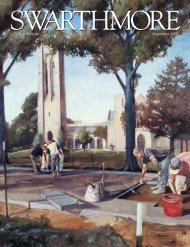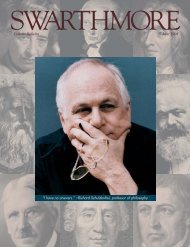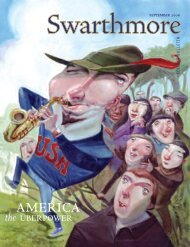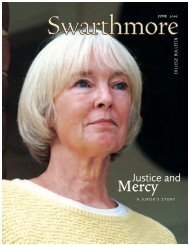A Walk in the Woods
Swarthmore College Bulletin (March 2001) - ITS
Swarthmore College Bulletin (March 2001) - ITS
You also want an ePaper? Increase the reach of your titles
YUMPU automatically turns print PDFs into web optimized ePapers that Google loves.
A W a l k i n t h e W o o d sThe College Seems to Be Rais<strong>in</strong>g Its Crum ConsciousnessBy Susan Milius ’75Illustrations by Barbara Seymour ’63Roger Latham ’83, whoth<strong>in</strong>ks a lot aboutsuch matters, hasoffered a tour of some of <strong>the</strong>most important parts of <strong>the</strong>Crum <strong>Woods</strong>.I should be contemplat<strong>in</strong>g<strong>the</strong> nature of importance, butit’s Friday, it’s sunny, and it’sa perfect unw<strong>in</strong>d-<strong>in</strong>-<strong>the</strong>woodsafternoon. I f<strong>in</strong>dmyself wonder<strong>in</strong>g how <strong>the</strong>late James Michener ’29would beg<strong>in</strong> a sweep<strong>in</strong>g epiccalled “Crum.”He could certa<strong>in</strong>ly reach back to <strong>the</strong>17th century, when Swedes put up a fortnot far away on T<strong>in</strong>icum Island, andadventurous souls started settl<strong>in</strong>g along<strong>the</strong> creek. Today’s name for it reportedlydescends from <strong>the</strong>ir Cromkill or Crumkill,mean<strong>in</strong>g “crooked creek.” But why limit<strong>the</strong> action to <strong>the</strong> paltry centuries s<strong>in</strong>ceEuropean arrival? Pennsylvania statearchives refer to earlier residents: <strong>the</strong>“Ockanickon” tribe.Or why not go for <strong>the</strong> full Michenertreatment, with swirl<strong>in</strong>g plasma lump<strong>in</strong>g<strong>in</strong>to a planet with eons of geologic wr<strong>in</strong>kl<strong>in</strong>g and crackl<strong>in</strong>g on itssurface? He’d have a fair diversity of landscape to expla<strong>in</strong>, as today’smostly mild-mannered creek slides by swamps, meadows, and steephills. I check College hold<strong>in</strong>gs on Roger’s map. The 140 woodedacres on <strong>the</strong> ma<strong>in</strong> campus crawl northward from <strong>the</strong> Yale Avenuebridge <strong>in</strong> <strong>the</strong> shape of a pudgy <strong>in</strong>chworm.Roger, however, skips Michener’s Big Bang and jumps to a modernBig Oops.He taught plant ecology at <strong>the</strong> College dur<strong>in</strong>g <strong>the</strong> late ’90s, and,before he resigned to do environmental consult<strong>in</strong>g, he analyzed <strong>the</strong>Crum’s importance as a teach<strong>in</strong>g resource and a biological community.He found that easily a dozen faculty members, from artists tozoologists, send from 150 to 300 students each year <strong>in</strong>to <strong>the</strong> woodsfor class projects.Roger identified six patches of particular ecological <strong>in</strong>terest—just <strong>the</strong> start of a list, he says (see map, page 20). These gemsAsk anybody who spenttime at Swarthmore, and<strong>the</strong>y have memories of <strong>the</strong>Crum—some sunny andsome dark.deserve particular attention,but if <strong>the</strong> College’s woods areto keep <strong>the</strong>ir biological valuefor teach<strong>in</strong>g, <strong>the</strong> place needsmore protection from <strong>the</strong> illsof surround<strong>in</strong>g development.“Crum <strong>Woods</strong> are a pricelessfacility for education that isbe<strong>in</strong>g allowed to deteriorateneedlessly,” Roger says. Hispo<strong>in</strong>t: This is one lab thatcan’t be replaced. If bad managementlets it degrade, <strong>the</strong>College can’t build ano<strong>the</strong>rCrum.“I didn’t really th<strong>in</strong>k anybody wouldread my report for months,” Roger says. Injust a few days, however, Larry Schall ’75,College vice president for facilities andservices, phoned.Larry, too, had been analyz<strong>in</strong>g <strong>the</strong>campus and <strong>the</strong> Crum as part of an overallstrategy for plann<strong>in</strong>g for new facilities that<strong>the</strong> College will almost certa<strong>in</strong>ly need <strong>in</strong><strong>the</strong> future. He was consider<strong>in</strong>g a proposal—s<strong>in</strong>ceabandoned—to move some athleticfields to <strong>the</strong> far side of <strong>the</strong> creek andmake <strong>the</strong>m accessible by a foot bridge.When <strong>the</strong>y talked, Roger found that <strong>the</strong> bridge might be placedatop one of his six gems.Larry, of course, had not declared war on ecologically valuablewetlands and did understand <strong>the</strong> teach<strong>in</strong>g value of <strong>the</strong> woods.Some of his own formative experiences with fluid dynamics camefrom Professor Alburt Rosenberg’s “Physics for Poets” class excursionsto watch leaves float<strong>in</strong>g down <strong>the</strong> creek. Larry and Roger simplyfound an alternative place to put a footbridge, should anyonedecide to build one.This <strong>in</strong>cident, among o<strong>the</strong>rs, <strong>in</strong>spired a new committee to makesure right hands knew what left hands were up to and that allhands would shake on it. Several long-term advocates for <strong>the</strong> Crumhave jo<strong>in</strong>ed <strong>the</strong> effort, now chaired by Arthur McGarity, an environmentaleng<strong>in</strong>eer<strong>in</strong>g professor who has been send<strong>in</strong>g students tostudy <strong>the</strong> creek’s water quality for <strong>the</strong> past 15 years. The Collegeseems to be rais<strong>in</strong>g its Crum consciousness considerably.M A R C H 2 0 0 117
















